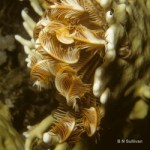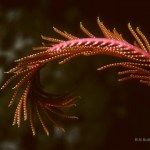Echinoderms
Everyone knows that some terrestrial animals are active primarily at night and sleep most of the day, while others go about their business during daylight hours and rest when it's dark. For some reason, many people are surprised to learn that the same thing holds true for animals that live in the sea.
One of the many marine animals that works the night shift is the crinoid species pictured here: Lampometra klunzingeri, a member of the Mariametridae family. During daylight hours, these crinoids hide in crevices in the reef. Shortly before sunset, like clockwork, they emerge from their…
Crinoids, a class of marine animals in the phylum Echinodermata, are pretty creatures. The photo at right shows a crinoid perched on a Malaysian reef with its fluffy arms extended for feeding. Looking at the photo, it's easy to see how they acquired their common name, Feather Stars.
This is how divers usually see crinoids, and this is how they are most often photographed. As pretty as crinoids are -- and they come in a vast array of colors -- photographs of the whole animal don't reveal much about the animal's structure or behavior. Whole-animal photos of creatures like this should be…
Even the clearest water has at least some particles suspended in it -- sand, silt, plankton, who knows what -- and most of the time, in most places, the water isn't really all that clear. In fact, during a plankton bloom or after a storm that has caused a lot of runoff, you might just as well leave your camera on the boat. Light from a camera strobe has a nasty habit of bouncing back from any particulate matter that it encounters between the camera lens and the subject. The result is the bane of underwater photography: backscatter. Your images will look as though they were taken in a…
A complete ban on fishing can save coral reef communities in more ways than one. A few weeks ago, I blogged about a study which found that the coral trout, a victim of severe overfishing, was bouncing back in the small regions of the Great Barrier Reef where fishing has been totally forbidden. It certainly makes sense that fish will rebound when fishing ceases, but a new study reveals that the bans have had more indirect benefits - they have protected the corals from a predatory starfish.
The crown-of-thorns starfish (Acanthaster planci) is a voracious hunter of corals and a massive problem…
Many animals have cunning ways of hiding from predators. But the larva of the sand dollar takes that to an extreme - it avoids being spotted by splitting itself into two identical clones.
Sand dollars are members of a group of animals called echinoderms, that include sea urchins and starfish. An adult sand dollar (Dendraster excentricus) is a flat, round disc that lives a sedate life on the sea floor. Its larva, also known as a pluteus, is very different, a small, six-armed creature that floats freely among the ocean's plankton.
A pluteus can't swim quickly, so there is no escape for one…


